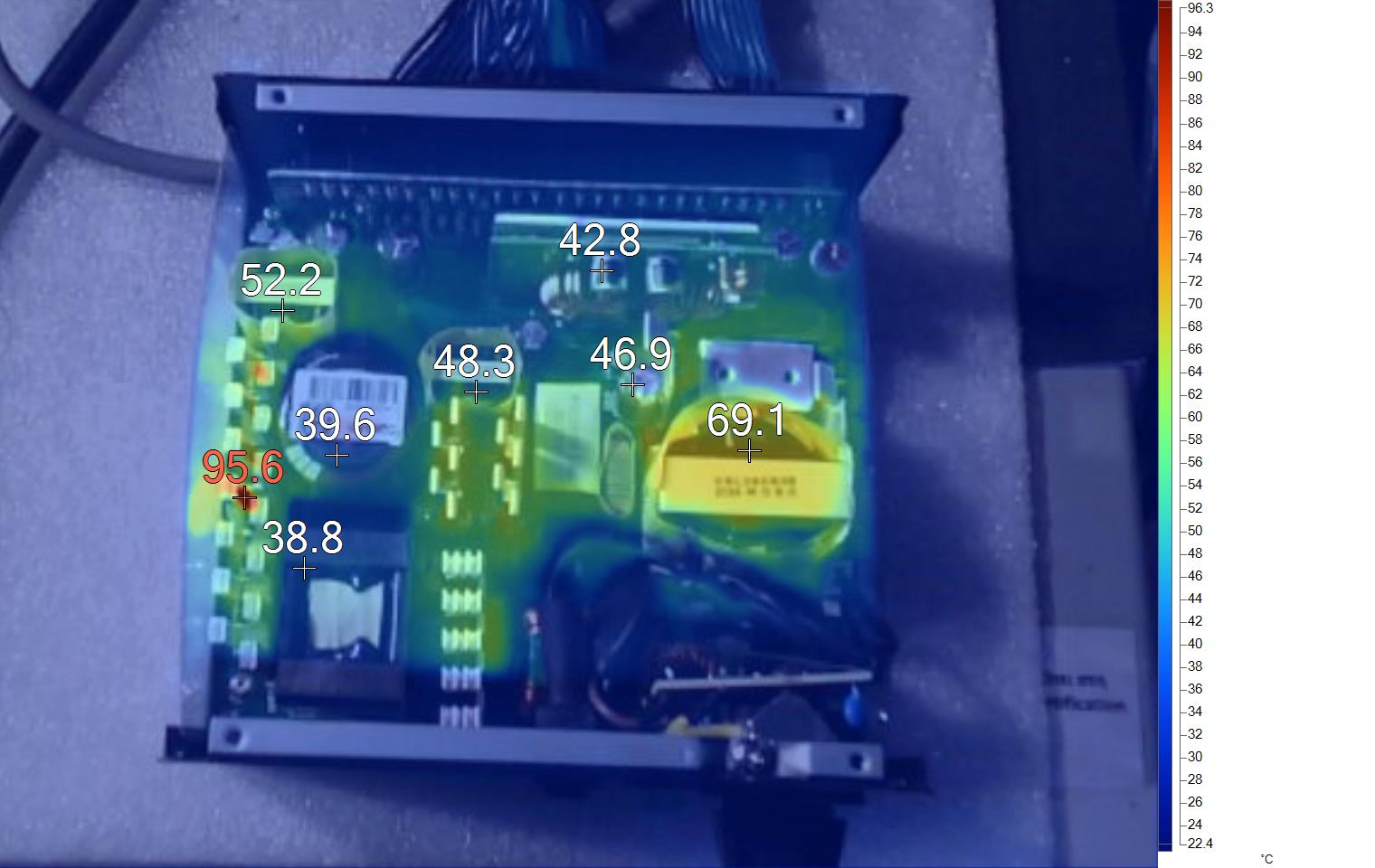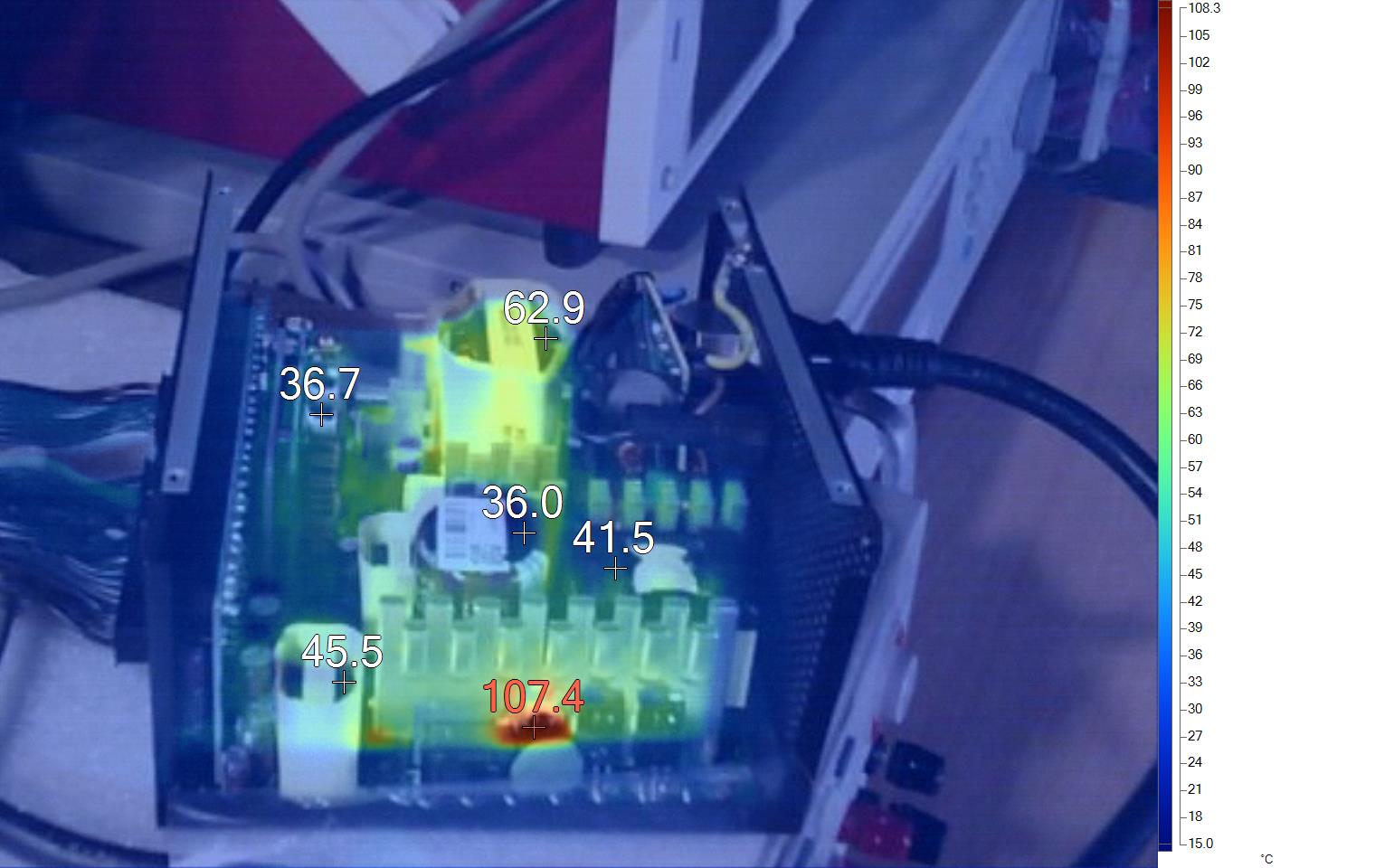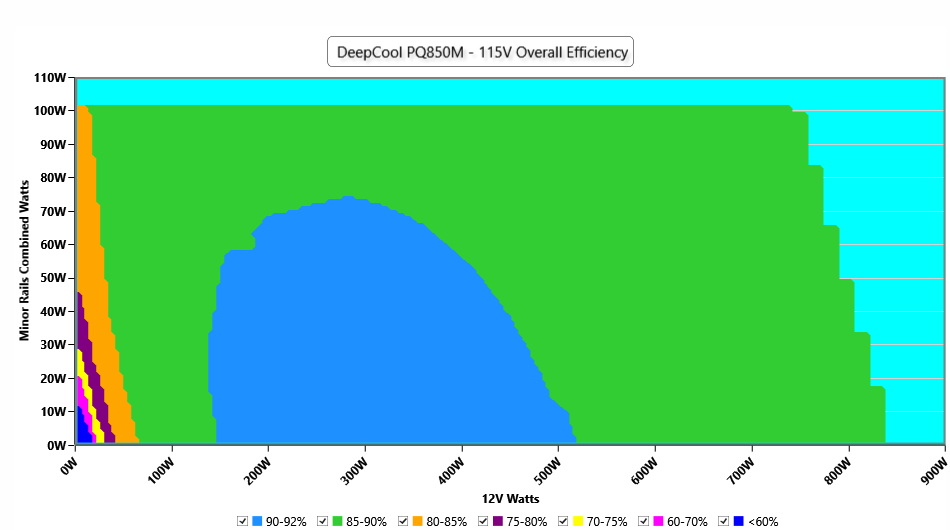Why you can trust Tom's Hardware
Protection Features
Check out our PSUs 101 article to learn more about PSU protection features.
| OCP (Cold @ 26°C) | 12V: 99.6A (141.71%), 12.102V 5V: 27.3A (136.5%), 5.019V 3.3V: 26.8A (134%), 3.338V 5VSB: 6.3A (210%), 4.971V |
| OCP (Hot @ 43°C) | 12V: 83.2A (118.86%), 12.033V 5V: 27.2A (136%), 4.990V 3.3V: 26.6A (133%), 3.314V 5VSB: 6.2A (206.67%), 4.952V |
| OPP (Cold @ 27°C) | 1200.61W (142.93%) |
| OPP (Hot @ 43°C) | 1001.06W (119.17%) |
| OTP | ✓ (147°C @ secondary side) |
| SCP | 12V to Earth: ✓ 5V to Earth: ✓ 3.3V to Earth: ✓ 5VSB to Earth: ✓ -12V to Earth: ✓ |
| PWR_OK | Accurate but lower than 16ms |
| NLO | ✓ |
| SIP | Surge: MOV Inrush: NTC Thermistor & Bypass relay |
The OCP triggering points at low temperatures are higher than usual, but this doesn't affect the PSU's operation. With increased temperatures, OCP at 12V drops notably lower, protecting the platform more effectively. The same goes for OPP. At low temperatures, it is pretty high, while with increased ambient, it drops 200W lower. We don't usually see so much difference in OCP and OPP under cold and hot conditions.
DC Power Sequencing
According to Intel’s most recent Power Supply Design Guide (revision 1.4), the +12V and 5V outputs must be equal to or greater than the 3.3V rail at all times. Unfortunately, Intel doesn't mention why it is so important to always keep the 3.3V rail's voltage lower than the levels of the other two outputs.



No problems here since the 3.3V rail is always lower than the other two.
Cross Load Tests
To generate the following charts, we set our loaders to auto mode through custom-made software before trying more than 25,000 possible load combinations with the +12V, 5V, and 3.3V rails. The deviations in each of the charts below are calculated by taking the nominal values of the rails (12V, 5V, and 3.3V) as point zero. The ambient temperature during testing was between 30 to 32 degrees Celsius (86 to 89.6 degrees Fahrenheit).
Load Regulation Charts




Efficiency Graph
Ripple Graphs
The lower the power supply's ripple, the more stable the system will be and less stress will also be applied to its components.




Infrared Images
We apply a half-load for 10 minutes with the PSU's top cover and cooling fan removed before taking photos with a modified Fluke Ti480 PRO camera able to deliver an IR resolution of 640x480 (307,200 pixels).
Get Tom's Hardware's best news and in-depth reviews, straight to your inbox.





Without active cooling, the boost diode gets hot, very hot. This is strange since it is firmly secured on the APFC heat sink, using a thermal pad for better contact. Nonetheless, this diode can handle 8A with 125 degrees Celsius junction temperature.
MORE: Best Power Supplies
MORE: How We Test Power Supplies
MORE: All Power Supply Content
Current page: Protection Features, DC Power Sequencing, Cross-Load Tests and Infrared Images
Prev Page Load Regulation, Hold-Up Time, Inrush & Leakage Current, Efficiency and Noise Next Page Transient Response Tests, Timing Tests, Ripple Measurements and EMC Pre-Compliance Testing
Aris Mpitziopoulos is a contributing editor at Tom's Hardware, covering PSUs.
-
Co BIY This category seems to show all the competitors neck-and-neck. Are they all using the SeaSonic Gold Platform ?Reply
I don't mind the grid pattern and perhaps it's excellent airflow allowed for less fan.
I think it looks particularly sharp on the back. -
drajitsh It is not ideal to buy a PSU right now because we are in a transition phase from the previous ATX spec to the new one. I am likely going to be forced to buy 2 systems for my office. They will have integrated graphics to start with and will be upgraded to low end discrete graphics in 1-2 years. Does your recommendation still stand?Reply -
Co BIY Replydrajitsh said:It is not ideal to buy a PSU right now because we are in a transition phase from the previous ATX spec to the new one. I am likely going to be forced to buy 2 systems for my office. They will have integrated graphics to start with and will be upgraded to low end discrete graphics in 1-2 years. Does your recommendation still stand?
I don't think low end cards will be requiring the new connectors in the short term. This is a necessity only for the high end cards with crazy peak power draws.
The makers of the low end cards will also build them to match the likely customer , you and the other 500 million people running machines without the ATX3.0 PSU upgrades.
Question: Why are PSU's built with fan grills ? None of the other fans in PCs have grills and PSU fans aren't bigger or faster . Also readily replaceable fans could be a great selling point because users want to mod. -
Co BIY ReplyTom Sunday said:The old story...eveyone wants a piece of the pie! Deepcool once dedicated exclusively for PC cooling now into PSU's as well. Next we have Seasonic making memory. I wish that companies would perfect their originally intended product line and giving us those results, instead of just plastering their nane on products made by others. I have no respect for this as it is a quick fix to make more money and even having some people believe that they have a better product when this is absolutely not the case .
I agree with you if they just slap their "Premium" name and a few RGB's to something of below average quality and then throw it out there at a Premium price.
In this case they started with a very solid platform, executed it competently and it delivers the goods quietly.
This PSU doesn't seem like it's worth getting the pitchforks out for. -
Co BIY ReplyTom Sunday said:Yes you are on the point as always!
Thank You for the compliment!
Tom Sunday said:My other 'Deepcool' thought and great hope was that someday perhaps air-cooling products will equal the thermal performance of AIO’s. In part many users even with extensive experience sometimes have trouble installing AIO’s into their case.
I agree with you that the simplicity, reliability and cost advantages of air cooling justify continued development. Lenovo has an interesting offset stacked air cooler design on their new Threadripper workstations that I would like to see make it to the DIY market .
Lenovo Thinkstation P620 Review (at Anandtech)
